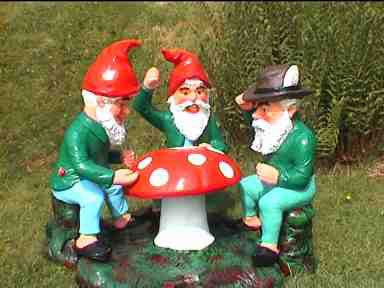Are garden gnomes making a comeback?

Think of garden gnomes and a few words might spring to mind. Tacky? Vulgar? Cheap? You’re not the only one who thinks so. In a recent survey by woodcare manufacturer, Ronseal, gnomes surpassed other unfashionable garden items by more than five times, with 53 per cent of those interviewed ranking them as naffer than crazy paving, stone animals water features and even wind chimes. But the poor old gnome wasn’t always such a slur on good taste.
Search for the perfect furniture with The Independent house and home database, powered by mydeco.
The first garden gnomes were made in the mid-19th century in Grafenroda, a town known for its ceramics in Thuringia, Germany. Here, Philip Griebel and August Heissner made decorative terracotta animals and produced gnomes based on local myths, which stated that gnomes would help and protect gardens at night.
Gnomes quickly spread across Germany, France and the UK, where they featured in many aristocratic gardens of the day. The first recorded appearance of gnomes in the UK was in 1867 in the gardens of Lamport Hall in Northamptonshire, where 21 miniature figurines had been brought from Germany by Sir Charles Isham, a spiritualist who believed in their protective powers.
In his book, Victorian Gardens, Brent Elliot, archivist to the Royal Horticultural Society, writes about Isham's garden at Lamport Hall, noting that there was "a toy monkey swinging from one of the miniature trees" and "a rockery swarming with miniature china figures, mostly gnomes of continental provenance."
By the late 19th century, this fad for garden ornaments and figurines amongst aristocratic class families had filtered down the social scale. Griebel and Heissner had started mass producing garden gnomes in around 1872 and, as other producers jumped on the band-wagon, every Victorian suburban garden became filled with brightly coloured nick-nacks.
Middle class worry soon set in and gnomes fell out of favour. Indeed, Ishram's daughters wasted no time in getting rid of every ornament and figurine they could find in the Lampton Hall garden. Only one gnome from their father's collection survived, Lampy, who remained hidden and, in 1997, was insured for £1 million as the world's oldest gnome.
Gnomes' fall from grace was cemented by two things, according to Ann Atkin, who founded a Gnome Reserve in Devon 32 years ago, which she still runs today.
The first, was Walt Disney’s 1937 film, Snow White and Seven Dwarfs, in which the dwarfs were portrayed as gnomes. Walt Disney "changed their faces," says Ann, "he came along and made them look a bit cute and stupid. They were much better before with wise looking faces – old and wizened and yet young at the same time."
The second thing was that, instead of being made from "terracotta and white earthenware," gnomes started being made in plastic. "People didn't like plastic," says Ann, who nonetheless takes in plastic gnomes at the Gnome Reserve because, "well, they can't help it, can they?"
Common, plastic and stupid-looking, gnomes have been reviled as the epitome of bad taste for years, but, of late, there seems to be a change in the air.
This May, The Royal Horticultural Society grudgingly lifted its long-standing ban on garden gnomes to allow gnome designer, David Domoney’s World Cup gnome mascot into the prestigious Chelsea Flower Show. Last May a member of the Royal Horticultural Society's ruling council, Jekka McVicar smuggled her "lucky" gnome into the central Grand Pavilion there and put him on display. Meanwhile, next year, an American-Britsh CGI animated film entitled Gnomio and Juliet will come to our screens, retelling Shakepeare's Romeo and Juliet with garden gnomes.
A renewed interest in gnomes is something that Nick Davies, Managing Director of wholesale garden supplier Solus, saw coming and the reason why, in 2008, Solus launched a new garden gnome collection called Woodland Wilf. "A few years ago, we felt that gnomes were going to come back," explains Nick. "It seems that, since then, demand has just grown consistently year on year."
At Ann Atkin's Gnome Reserve, there is no shortage of interest. Indeed, young and old come to visit the 1000 plus gnomes and pixies which reside there. Each visitor to the Reserve is given a gnome hat on arrival, which helps turn them into "honorary gnomes" while they're there. Ann subscribes fully to the magic of gnomes, which she says "add another dimension to life" and "take you away from all the miseries. We seldom see people coming up the drive whose faces don’t break into smiles before they get in," she points out.
There is something about gnomes which we can't resist, it seems, but will they ever be considered of good taste? And, if not, will we ever feel comfortable putting them in our gardens? According to Guy Pullen, manager of outdoor plants at Clifton Nurseries, London, it's simple: "garden gnomes never were and never shall be tasteful – but that doesn’t mean to say you shouldn't have them in your garden." Good taste, it has to be said, is rather overrated anyway.
Emily Jenkinson is interiors writer for furniture and interior design website mydeco.com.
Join our commenting forum
Join thought-provoking conversations, follow other Independent readers and see their replies
Comments